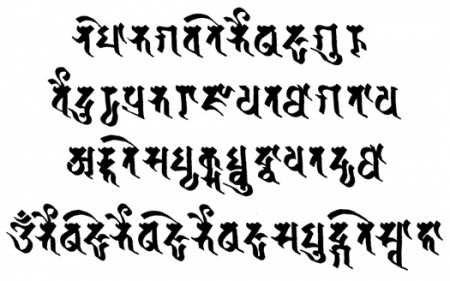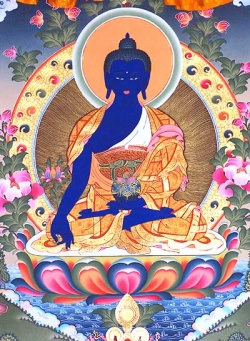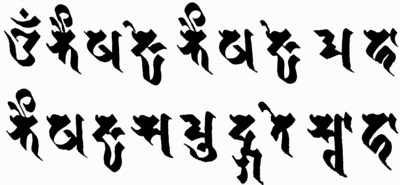Difference between revisions of "Bhaiṣajyaguru - the Medicine Buddha Mantra"
| Line 9: | Line 9: | ||
[[File:Bhaisajyaguru.png|thumb|250px|bhai ṣa jya gu ru]] | [[File:Bhaisajyaguru.png|thumb|250px|bhai ṣa jya gu ru]] | ||
[[Bhaiṣajyaguru]] the [[medicine Buddha]] is a slightly enigmatic figure. His [[mythology]] goes back to [[early Buddhism]], but his origins are obscure, being perhaps related to texts where the [[historical Buddha]] is described as a [[physician]] come to cure the ills of the [[world]]. [[Bhaiṣajyarāja]] is the [[name]] of a [[Bodhisattva]] in the [[Saddharma Puṇḍarīka]] or [[White Lotus Sūtra]] who immolates himself as an [[offering]] to the [[Buddha]]. | [[Bhaiṣajyaguru]] the [[medicine Buddha]] is a slightly enigmatic figure. His [[mythology]] goes back to [[early Buddhism]], but his origins are obscure, being perhaps related to texts where the [[historical Buddha]] is described as a [[physician]] come to cure the ills of the [[world]]. [[Bhaiṣajyarāja]] is the [[name]] of a [[Bodhisattva]] in the [[Saddharma Puṇḍarīka]] or [[White Lotus Sūtra]] who immolates himself as an [[offering]] to the [[Buddha]]. | ||
| + | |||
He is depicted as deep blue in {{Wiki|colour}}, dressed in [[bhikṣu's]] [[robes]], holding his [[begging bowl]] in his left hand and with his right hand making the [[varada mudra]]. [[Varada]] means 'granting wishes, conferring a boon, ready to fulfill requests or answer [[prayers]]'. Sometimes, especially in {{Wiki|East Asian}} [[iconography]], the [[begging bowl]] is replaced by a [[medicine]] jar; in [[Tibetan]] images a [[myrobalan]] plant, [[thought]] to be a [[panacea]], grows out of the [[bowl]]. | He is depicted as deep blue in {{Wiki|colour}}, dressed in [[bhikṣu's]] [[robes]], holding his [[begging bowl]] in his left hand and with his right hand making the [[varada mudra]]. [[Varada]] means 'granting wishes, conferring a boon, ready to fulfill requests or answer [[prayers]]'. Sometimes, especially in {{Wiki|East Asian}} [[iconography]], the [[begging bowl]] is replaced by a [[medicine]] jar; in [[Tibetan]] images a [[myrobalan]] plant, [[thought]] to be a [[panacea]], grows out of the [[bowl]]. | ||
| Line 20: | Line 21: | ||
===Transliteration=== | ===Transliteration=== | ||
| − | [[oṃ bhai | + | [[oṃ bhai ṣa [[jye]] [[bhai]] ṣa ye ma hā]] |
[[bhai ṣa jya sa mu dga te svā hā]] | [[bhai ṣa jya sa mu dga te svā hā]] | ||
| Line 39: | Line 40: | ||
| − | There seems to be a great deal of variation in the romanization of this [[mantra]]. This [[uchen]] [[script]] version is the same [[Tibetan]] spelling as on Andy Weber's postcard - so should be authoritative. This would Romanise literally as: | + | There seems to be a great deal of variation in the romanization of this [[mantra]]. This [[uchen]] [[script]] version is the same [[Tibetan]] spelling as on [[Andy Weber's]] postcard - so should be authoritative. This would Romanise literally as: |
| − | :[[oṃ | + | :[[oṃ bhe ṣa dzye bhe ṣa dzye ma hā bhe ṣa dzye rā dza ye sa mu dga te svā hā]] |
Note the [[bhaiṣajyarāja]] one of many variations. However, the pronunciation is something like: | Note the [[bhaiṣajyarāja]] one of many variations. However, the pronunciation is something like: | ||
| − | :om beh ka dze-yah beh ka dze-yah ma ha beh ka dze-yah la dza sah mo kyah deh sowa ha | + | :[[om beh ka dze-yah beh ka dze-yah ma ha beh ka dze-yah la dza sah mo kyah deh sowa ha]] |
Revision as of 19:41, 9 January 2024
Click here to see other articles relating to word Bhaiṣajyaguru - the Medicine Buddha Mantra
Bhaiṣajyaguru the medicine Buddha is a slightly enigmatic figure. His mythology goes back to early Buddhism, but his origins are obscure, being perhaps related to texts where the historical Buddha is described as a physician come to cure the ills of the world. Bhaiṣajyarāja is the name of a Bodhisattva in the Saddharma Puṇḍarīka or White Lotus Sūtra who immolates himself as an offering to the Buddha.
He is depicted as deep blue in colour, dressed in bhikṣu's robes, holding his begging bowl in his left hand and with his right hand making the varada mudra. Varada means 'granting wishes, conferring a boon, ready to fulfill requests or answer prayers'. Sometimes, especially in East Asian iconography, the begging bowl is replaced by a medicine jar; in Tibetan images a myrobalan plant, thought to be a panacea, grows out of the bowl.
Mantra
Transliteration
[[oṃ bhai ṣa jye bhai ṣa ye ma hā]] bhai ṣa jya sa mu dga te svā hā
oṃ bhaiṣajye bhaiṣajye mahābhaiṣajya-samudgate svāhā ओं भैषज्ये भैषज्ये महाभैषज्यसमुद्गते स्वाहा
Tibetan
Sanskrit Spelling
Tibetan Spelling and Pronunciation
There seems to be a great deal of variation in the romanization of this mantra. This uchen script version is the same Tibetan spelling as on Andy Weber's postcard - so should be authoritative. This would Romanise literally as:
Note the bhaiṣajyarāja one of many variations. However, the pronunciation is something like:
Notes
There are many variations on this mantra, and some other mantras and dhāraṇī associated with Bhaiṣajyarāja. In Sanskrit bhaiṣajya can mean: curativeness, healing efficacy; a ceremony performed as a remedy for sickness; any remedy, drug or medicine; the administering of medicines. Guru is teacher. The word svāhā comes from Vedic ritual.
For more information on this mantra on Bhaiṣajyaguru and his mantra see the Wildmind Bhaiṣajyaguru page
This mantra can be found the Sūtra of the Medicine Buddha [pdf file] (Taisho XIV, 450) where it is described as a great dhāraṇī. In the sūtra the mantra is introduced by the words:
namo bhagavate bhaiṣajyaguru vaiḍūryaprabharājāya tathāgatāya arhate samyaksambuddhāya tadyathā
- homage to the blessed medicinal teacher, to the king of jewel-like radiance, to the one who is like that, the worthy, the fully awakened one, thus:
In Siddhaṃ this looks like:

namo bhagavate bhaiṣajyaguru
vaiḍūryaprabharājāya tathāgatāya
arhate samyaksambuddhāya tadyathā
oṃ bhaiṣajye bhaiṣajye mahābhaiṣajya samudgate svāhā
नमो भगवते भैषज्यगुरु
वैडूर्यप्रभराजाय तथागताय
अर्हते सम्यक्सम्बुद्धाय तद्यथा
ओं भैषज्ये भैषज्ये महाभैषज्यसमुद्गते स्वाहा




